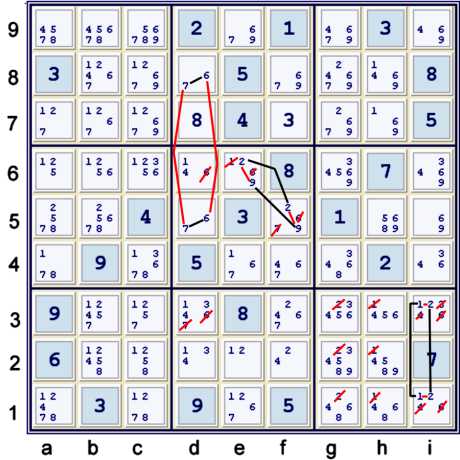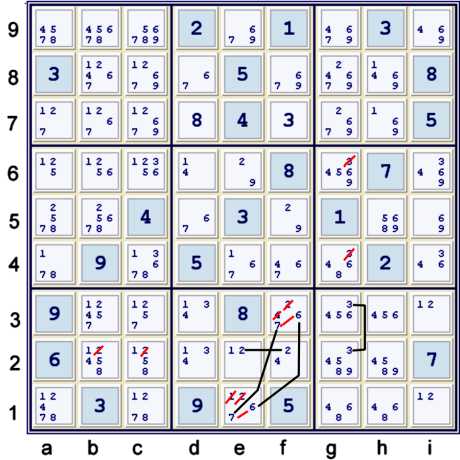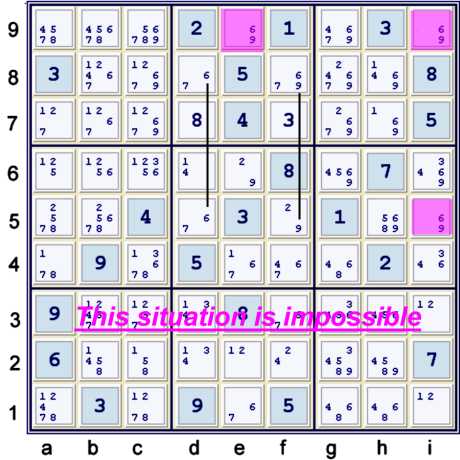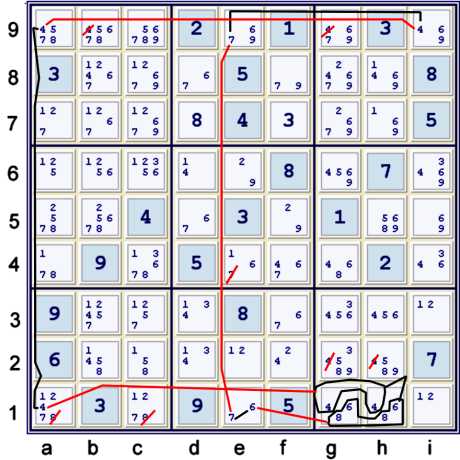The following illustrated proof for the diabolical & extreme
Unsolvable #13 employs
an imposing variety of techniques. Advanced Forbidding Chains would be my
general description of the toughest ones used herein. Any technique, including primarily a Forbidding Chain (also called
Alternating Inference Chain (AIC) may be used as an argument in the chain. If this is
your first visit to this blog, WELCOME!!
Certainly, the terminology used here is not the standard terminolgy used in many other Sudoku
sites. Therefor, previous blog pages may be helpful. Links to these pages are found to the right,
under Sudoku Techniques. The list expands rapidly, so specifically, one may want
to refer to the following pages:
The illustrations of forbidding chains, also called
Alternating Inference Chains (AIC), shown in this proof will share this key:
- black line = strong inference performed upon a set (strong link)
- red line = weak inference performed upon a set (weak link)
- black containers define a partioning of a strong set(s)
- candidates crossed out in red = candidates proven false
Please be aware that, for me,
strong and weak need not be mutually exclusive properties.
This puzzle is meant to be very difficult, thus the proof is far from trivial. Please accept
my gratitude for your forbearance!
Unsolvable #13
Two Unique Possibilities are available here:
- d7 = 8% box +(hidden single in at least the box)
- f7 = 3% box +
Hidden Pairs are generally the next thing that I look for.
Hidden Pair 12, Hidden Pair 29 & Naked Pair 67

To save some space, I have chosen to illustrate a few steps simultaneously. Above, find:
- Hidden pair 12 at i13 => i13=12, g123≠2, h123≠1
- Hidden pair 29 at e6f5 => e6,f5=29
- Naked pair 67 at d58 => d6≠6, d3≠67
All of these techniques are illustrated as wrap-around, or continuous, forbidding chains (AIC).
Hidden Pair 67, Locked candidates 2 & 3

Again, I have combined some steps. Note that the locked 2s require the hidden pair eliminations
be made first. Illustrated above as forbidding chains are:
- Locked 3s at g23 => f46≠3
- Hidden Pair 67 at e1f3 => e1,f3=67
- Locked 2s at ef2 => bc2≠2
At this point, we have exhausted the
easy techniques. To get things started right, I
shall jump right in with one of the most complex steps this puzzle requires.
Clarification Illustration

Above, find an illustration of an impossible puzzle state. I am using this to help clarify
the next step. Because of the three cells, e9 = i9 = i5 = 69, and because of the two strong
inferences: d5=6 == d8=6, f5=9 == f8=9, the Possibility Matrix above is
false. One way to view it:
- e9=6 == e9=9 -- f8=9 == f5=9 -- i5=9 == i5=6 => i9≠6
- e9=9 == e9=6 -- d8=8 == d5=6 -- i5=6 == i5=9 => i9≠9
- i9 cannot be empty
Thus, if e9=69, then we have remote pairs 69 at e9,i5 => i9≠69.
One can write then: e9=x == e9=69 -- i9=69 == i9=y, which shortens to:
The step illustrated below uses that precise piece of information.
Please note, however, that a proof by contradiction of this piece of information is not the
only derivation possible. In fact, it is not my preferred derivation. Rather, it is included as
added weight in the following step.
An Almost Remote Pair used in a partially continuous forbidding chain

The illustration above probably does this step a disservice. It may be better to just ignore
the red lines, as they are implied by the puzzle rules. The black ones, however, are dependent
upon the individual puzzle, and are thus far more important. As a forbidding chain, one could
write:
- Let A = {e9=6 == e9=9 -- f8=9 == f5=9 -- i5=9 == i5=6 -- d5=6 == d8=6 -- e9=6 == e9=9}
- thus, A is remote pairs 69 at both cells e9,i5
- e9=7 == A -- i9=69 == i9=4 -- a9=4 == a1=4 -- gh1=4 == {pair 68 at gh1} -- e1=6 == e1=7
- => f8≠6, e4≠7, bg9≠4, ac1≠8, gh2≠8
The macro chain, if you will, is a continuous loop, as the endpoints, e9=7, e1=7 are in conflict
with each other. The contained Boolean A is also a continuous loop, but.... its connection to
the macro chain is asymmetrical. By that, I mean that it does not use the weak links that would
be proven strong to connect to the macro chain. A whole bit of theory could be developed here, but
suffice it to say that, as far as the macro chain is concerned, A is discontinuous. Thus, none
of its internal weak inferences are proven strong.
To further complicate the allowable deductions, the other contained Boolean, {pair 68 at gh1},
is a continuous nice loop. Therefor, the internal weak link that does not emanate from the chain,
g1=8 -- h1=8, is proven strong. Thus, the 8s shown crossed out above are eliminated. Also proven
strong by the macro chain:
- i9=4 == a9=4 => bg9≠4
- e9=7 == e1=7 => e4≠7
The Boolean A contains this partial
unconditional chain:
- f8=9 == f5=9 -- i5=9 == i5=6 -- d5=6 == d8=6 => f8≠6
What I mean by unconditional, is that all of the strong links used in that portion of the
chain exist in the current possibility matrix. Thus, one has that elimination no matter what.
Hopefully, this is almost as clear as mud.
A future blog page may entertain theorems that
exhaustively analyze partially continuous loops. I believe the name, Almost continuous
nice loops is used elsewhere to describe partially continuous loops.
Macro Chain only

Find above an attempt to clarify this elimination group. The Almost Remote Pair portion of the
chain has been removed. Also, the one elimination based upon that portion of the chain has been made.
The conclusion of the Almost Remote Pair portion of the chain is: i9=4 == e9=7, illustrated
above. The macro chain is clearly a wrap-around, or continuous loop, chain:
- e1=6 == e1=7 -- e9=7 == i9=4 -- a9=4 == a1=4 -- gh1=4 == {gh1=pair 68}
Since e1=6 and gh1=pair 68 are in conflict with each other,
- e1=7 == e9=7 => e4≠7
- i9=4 == a9=4 => bg9≠4
- gh1=4 -- gh1=6 => gh1 is not pair 46 => g1=8 == h1=8 => ac1,gh2≠8
The last of these conclusions is perhaps the hardest to understand, but in a continuous loop chain,
not only are all the weak inferences proven strong, but all the strong inferences are proven
weak.
Another way to understand it? Consider that the chain clearly shows:
- e1=6 == a1=4 Look at e1=6 == e1=7 -- e9=7 == i9=4 -- a9=4 == a1=4
- {pair 46 at gh1} -- {e1=6 == e1=4} -- {pair 46 at gh1}
- {pair 46 at gh1} == {pair 8x at gh1} => g1=8 == h1=8 => ac1,gh2≠8
Since the macro chain already considers all the contents of the cells, gh1, we are not using any
new information to make this elimination deduction.
This concludes the first page of this proof. There remain some very interesting
steps. To find some of these, please visit the
next page.